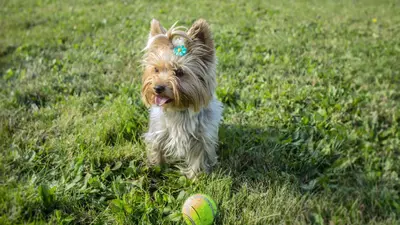Staffordshire Bull Terrier: Breed Guide
- 29 Nov 2019
- 5m read

Deservedly one of the UK's top five most popular dog breeds, the Staffordshire Bull Terrier (or Staffy for short) can be the ideal family pet. Extremely loyal, they're bundles of fun and are known as the nanny dog*. Looking after your four-legged pal means choosing food that gives them the goodness they need while tempting their taste buds and encouraging clean bowls.
*This is thanks to their fondness for children. Having said that, it goes without saying that it’s best to have humans look after small children, not your pets.
Any bodybuilder will tell you that a diet rich in protein is important if you want strong muscles. It's the same for dogs. Just like music from the 80s, Staffies are seriously high energy, thriving on one or two hours of exercise every day. Protein-packed meals will help keep their muscles fit and healthy, ready for racing round the park with their friends.
Based on our current customers, we estimate that adult Staffies need around 716 calories per day. This can vary based on your pooch’s age, weight and activity level.
Are Staffies Dangerous?
Staffies are one of few breeds that are unfairly assumed to be dangerous, aggressive dogs. But this is most often not the case. The Kennel Club states that there is no scientific evidence to suggest that Staffies are any more dangerous than other breeds.
Like all dogs, the temperament of Staffies is largely a result of how they are bred, trained and cared for. Dogs that are mistreated, abused or badly socialised are likely to display unfavourable behaviour, often in the form of snarling and biting.
Back in 2018, the Government rejected a proposal to add Staffies to the Dangerous Dogs Act. This came after over 163,000 people signed a counter-petition arguing that the breed did not belong on the list as they did not possess the same qualities as the four breeds currently banned.
When treated properly, Staffies are incredibly loving, loyal and sociable. Their reputation is (thankfully) on the rise as more and more people become educated in the correct treatment of dogs.
Do Staffies Shed?
Yes, Staffies do shed.
However, due to their single coat, they are considered relatively low-shedders. Grooming your Staffie every few days with a soft bristle brush will help to minimise the overall volume of hair being lost.
How Much Exercise Does a Staffy Need?
According to the PDSA, Staffies need a minimum of one hour of exercise per day. This can be split into two or more walks but it is recommended that they are allowed sufficient time off-lead to expel energy. In addition to this, you should ensure that plenty of time is dedicated to play and challenges, such as tug of war or ‘hide and treat’ scent work.
Ensuring that your pooch is well-exercised will help to minimise their boredom levels, in addition to tiring them out. So when you think you’re too tired to take them out, consider it one less pair of shoes that are going to become their next chew toy. We hope this isn’t the case, but it’s always better to be safe than sorry.
When Do Staffies Stop Growing?
Typically, Staffies stop growing when they reach 12 months old.
However, in some cases it can take up to 18 months of age before they reach their full height and weight. With this extra growth comes more love and affection to go around, so be warned; licks and cuddles in large quantities incoming.
It's estimated that Staffies will grow up to 36 cm - 41 cm in height and weigh somewhere between 11kg and 17 kg. They are classed as a medium-sized dog.
How Much Do Staffies Cost?
According to research conducted by Pets4Homes UK, the average cost of purchasing a kennel-club registered Staffie is £965, and unregistered Staffies will cost closer to £468.
First and foremost, you should ensure that you’re buying your pup from a reputable breeder or rescue centre. This will ensure that your dog has been bred and cared for in the right circumstances.
A sound woof of advice from us, if it seems too good to be true it’s likely that it is. A dog is a huge investment in time, money and love, so make sure that you take the time to do plenty of research before making any decisions.
As well as the cost to purchase a Staffie, it is impawtent to be mindful of the other expenses involved when bringing a pooch into your life.
- Vaccines / flea & worming treatments- including initial and booster vaccines (usually once a year)
- Neutering / spaying- from 6 months old (unless advised otherwise by your Vet)
- Equipment- collar, harness, lead, bed, bowls, brushes, washes, toys, poo bags
- Food
- Insurance
- Daycare / boarding
Butternut Box is Perfect for Staffies
Staffies love their food, which can be a good and bad thing. On one hand, it means they don't turn up their noses at dinner time. On the other hand, they're prone to becoming overweight or obese. Obesity can lead to lots of other health issues and is one of the biggest problems facing pets in the UK – especially as most humans don't really know what their pet's ideal shape looks like. It's easy to think a slightly overweight dog looks normal.
Staffordshire Bull Terriers are champion farters. It's not really known why, but it could be down to difficulty digesting certain ingredients. So the food your dog eats can have a direct impact on their flatulence. High-protein foods made with quality meat and vegetables, like all of our recipes at Butternut Box, can help keep the farting to a minimum.
Here's a quick check: if you look at your Staffie from above and there's no visible waist, it's likely they're overweight and might be time for them to stop staffing (sorry) their faces.




